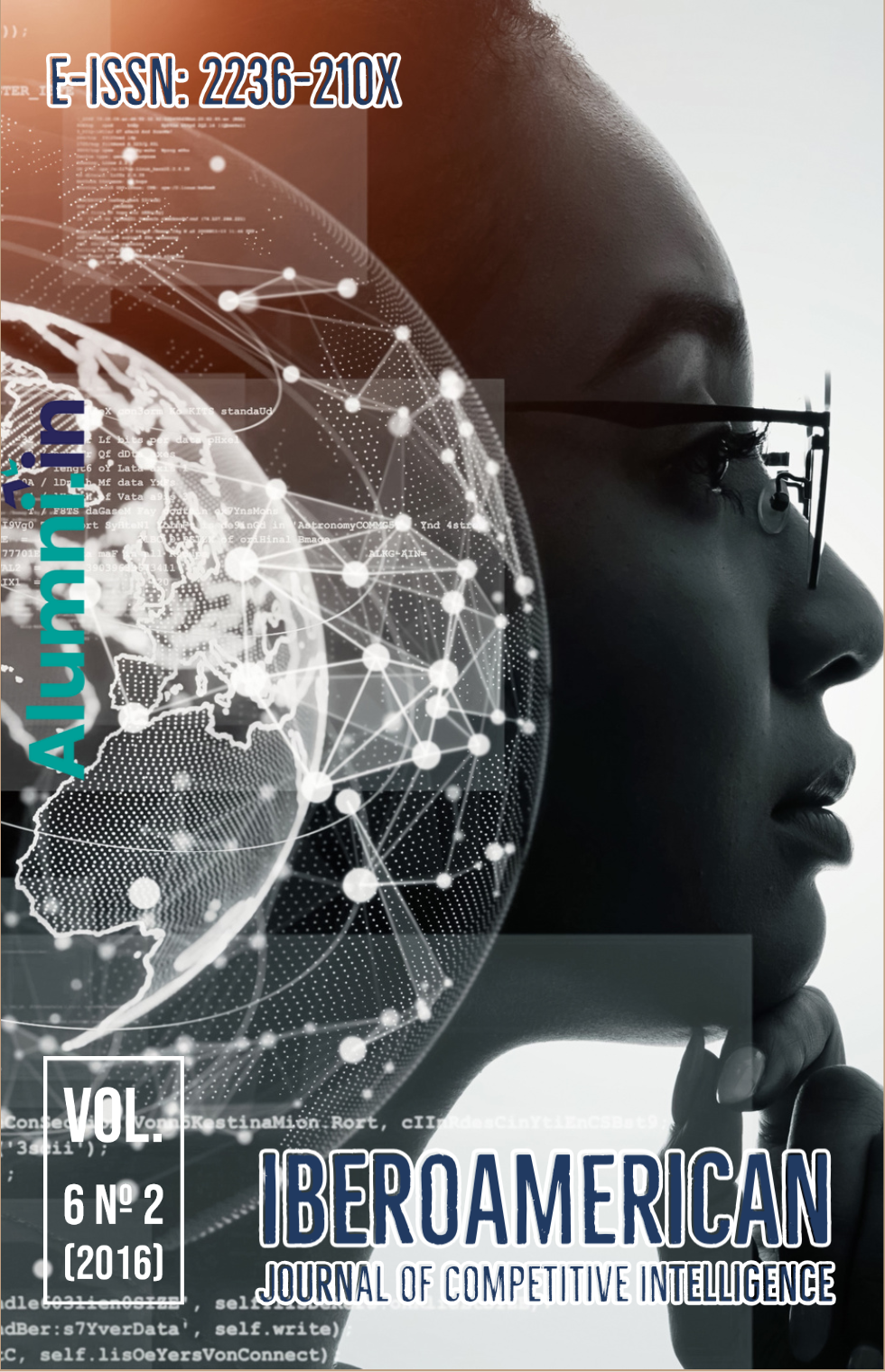INTELIGÊNCIA COMPETITIVA COMO FERRAMENTA ESTRATÉGICA EM ORGANIZAÇÕES COM P&D
DOI:
https://doi.org/10.24883/IberoamericanIC.v6i2.158Keywords:
Inteligência Competitiva, Gestão Organizacional, EstratégiaAbstract
O objetivo deste artigo é apresentar um levantamento a respeito do uso das premissas de inteligência competitiva e de inovação aberta nas empresas brasileiras que recorrem sistematicamente à P&D no desenho e na implantação de suas estratégias competitivas. A seleção das empresas foi intencional, tomando por base empresas brasileiras com reconhecido uso da P&D, e o instrumento de coleta de dados foi um questionário fechado. Os dados foram tratados por estatística descritiva e correlação linear múltipla. Os resultados evidenciaram um baixo uso — ou mesmo falta de compreensão — das premissas de estratégias de inovação que exigem maior mudança de modelo mental dos gestores de P&D, particularmente no que diz respeito ao papel dos modelos de negócio. Há também indícios de que as empresas pesquisadas subestimam os benefícios dos fluxos de conhecimento de dentro para fora da empresa. Por fim, a pesquisa traz evidências de que uma estratégia de inovação adequada tem o potencial de auxiliar as empresas brasileiras em processo de emparelhamento tecnológico.
Downloads
References
BARTLETT, C.; GHOSHAL, S. Going global: lessons from late movers. Havard Business Review, v. 78, n. 2, p. 132-142, Mar./Apr. 2000.
BOUDREAU, K.J.; LAKHANI, K.R. How to manage outside innovation. MIT Sloan Management Review, v. 50, n. 4, p. 69-75, 2009.
BELL, M.; PAVITT, K. The development of technological capabilities. In: HAQUE, I.U. (Ed.). Trade, technology and international competitiveness. Washington: World Bank, 1995. p. 69-101.
CHESBROUGH, H. W. Open innovation: a new paradigm for understanding industrial innovation. In: CHESBROUGH, H.W.; VANHAVERBEKE, W. J. Open innovation: researching a new paradigm. New York: Oxford University Press, 2006. p. 1-14.
CHESBROUGH, H.; CROWTHER A. K. Beyond high tech: early adopters of open innovation in other industries. R&D Management, v.36, n.3, p. 229-236, 2006. DOI: https://doi.org/10.1111/j.1467-9310.2006.00428.x
CHESBROUGH, H. W. Managing false negatives. Harvard Management Update, v. 13, n. 5, p. 3-4, 2008.
CHRISTENSEN, J. F. Whiter core competency for the large corporation in an open innovation world? In: CHESBROUGH, H.W.: VANHAVERBEKE, W. J. Open innovation: researching a new paradigm. New York: Oxford University Press, 2006.
COHEN, W.M.; LEVINTHAL, D.A. Absorptive capacity: a new perspective on learning and innovation. Administrative Science Quarterly, v.35, p.128-152, 1990. DOI: https://doi.org/10.2307/2393553
DAHLANDER, L.; GANN, D. M. How open is innovation? Research Policy, v.39, p.699-709, 2010. DOI: https://doi.org/10.1016/j.respol.2010.01.013
DAHLMAN, C.; WESTPHAL, L. E. Technological effort in industrial development. An interpretative survey of recent research. In: STEWART, F.; JAMES, J. The economics of new technology in developing countries. London: Francess Press, 1982.
DANTAS, E.; BELL, M. Latecomer firm and the emergence and development of knowledge networks: the case of Petrobras in Brazil. Research Policy, v. 38, p. 829-844, 2009. DOI: https://doi.org/10.1016/j.respol.2009.01.007
DOGSON, M.; GANN, D.; SALTER, A. The role of technology in the shift towards open innovation: The Case of Procter & Gamble. R&D Management., v. 36, n. 3, p. 333-346, 2006. DOI: https://doi.org/10.1111/j.1467-9310.2006.00429.x
FIGUEIREDO, P. N. Discontinuous innovation capability accumulation in latecomer natural resource-processing firms. Technology Forecasting & Social Change Journal, n. 77, p. 1090–1108, 2010. DOI: https://doi.org/10.1016/j.techfore.2010.02.004
FREEMAN, C. Technology policy and economic performance: lessons from Japan. Londres: Frances Pinter, 1987.
FREEMAN, C.; SOETE, L. The economics of industrial innovation. 3rd. ed. London: Frances Pinter, 1997.
GRANT, R. M. Toward a knowledge-based theory of the firm. Strategic Management Journal, v. 17, Special Issue, p. 109-122, 1996. DOI: https://doi.org/10.1002/smj.4250171110
GULATI, R. Alliances and networks. Strategic Management Journal, v. 19, p. 293-317, 1998. DOI: https://doi.org/10.1002/(SICI)1097-0266(199804)19:4<293::AID-SMJ982>3.0.CO;2-M
HACIEVLIYAGIL, N. K. The impact of open Innovation on technology transfers at Philips and DSM. M.Sc. Thesis − Delft University of Technology, Delft, 2007.
HAMBRICK, D. C. An empirical typology of mature industrial-product environments. Academy of Management Journal, v. 26, n. 2, p. 213-230, 1983. DOI: https://doi.org/10.5465/255971
HUSTON, L.; SAKKAB, N. Conectar e desenvolver: como funciona o novo modelo de inovação da Procter & Gamble. HBR Brasil, v. 84, n. 3, p. 28-36, mar. 2006.
JARRILLO, J. C. On strategic networks. Strategic Management Journal, v. 9, p. 31-41, 1998. DOI: https://doi.org/10.1002/smj.4250090104
KATZ, J. Domestic technological innovations and dynamic comparative advantage: further reflections on a comparative case-study program. Journal of Development. Studies, v.16, n. 1-2, p. 13-38, 1984. DOI: https://doi.org/10.1016/0304-3878(84)90100-7
KIM, L. Crisis construction and organizational learning: capability building in catching-up at Hyundai Motor. Research Policy, v. 9, n. 4, p. 506-521, 1998. DOI: https://doi.org/10.1287/orsc.9.4.506
LALL, S. Technological capabilities and industrialization. World Development, v. 20, n. 2, p. 165-186, 1992. DOI: https://doi.org/10.1016/0305-750X(92)90097-F
LANGLOIS, R. N. The vanishing hand: the changing dynamics of industrial capitalism. Industrial & Corporate Change, v. 12, n. 2, p. 351-385, 2003. DOI: https://doi.org/10.1093/icc/12.2.351
LAURSEN, K.; SALTER, A. Open for innovation: the role of openness in explaining innovation performance among U.K. manufacturing firms. Strategic Management Journal, v. 27, p. 131-150, 2006. DOI: https://doi.org/10.1002/smj.507
LEE, K.; LIM, C. Technological regimes, catching-up and leapfrogging: findings from the Korean industries. Research Policy, v. 30, p. 459-483, 2001. DOI: https://doi.org/10.1016/S0048-7333(00)00088-3
LUNDVALL, B. A. National Systems of Innovation: towards a theory of innovation and interactive learning. London: Pinter Publishers, 1992.
MALERBA, F. Sectoral systems of innovation and production. Research Policy, v. 31, DOI: https://doi.org/10.1016/S0048-7333(01)00139-1
p. 247-264, 2002.
MINTZBERG, H. Generic strategies: toward a comprehensive framework. Advances in Strategic Management Journal, v. 5, p 1-67, 1988.
NELSON, R.R.; WINTER, S.G. An evolutionary theory of economic change. Cambridge: Harvard University Press, 1982.
PISANO, G. P.; VERGANTI, R. Which kind of collaboration is right for you? Havard Business Review, v. 86, n. 12, p. 1-11, Dec. 2008.
SCHUMPETER, J. The theory of economic development. Cambridge: Harvard University Press, 1934.
TEECE, D.; PISANO, G.; SHUEN, A. Dynamic capabilities and strategic management. Strategic Management Journal, v. 18, n. 7, p. 509-533, 1997. DOI: https://doi.org/10.1002/(SICI)1097-0266(199708)18:7<509::AID-SMJ882>3.0.CO;2-Z
TROTT, P.; HARTMANN, D. Why “Open Innovation” is old wine in new bottles. International Journal of Innovation Management., v. 13, n. 4, p. 715-736, 2009. DOI: https://doi.org/10.1142/S1363919609002509
Downloads
Published
How to Cite
Issue
Section
License
Authors who publish with this journal agree to the following terms:
1. Authors who publish in this journal agree to the following terms: the author(s) authorize(s) the publication of the text in the journal;
2. The author(s) ensure(s) that the contribution is original and unpublished and that it is not in the process of evaluation by another journal;
3. The journal is not responsible for the views, ideas and concepts presented in articles, and these are the sole responsibility of the author(s);
4. The publishers reserve the right to make textual adjustments and adapt texts to meet with publication standards.
5. Authors retain copyright and grant the journal the right to first publication, with the work simultaneously licensed under the Creative Commons Atribuição NãoComercial 4.0 internacional, which allows the work to be shared with recognized authorship and initial publication in this journal.
6. Authors are allowed to assume additional contracts separately, for non-exclusive distribution of the version of the work published in this journal (e.g. publish in institutional repository or as a book chapter), with recognition of authorship and initial publication in this journal.
7. Authors are allowed and are encouraged to publish and distribute their work online (e.g. in institutional repositories or on a personal web page) at any point before or during the editorial process, as this can generate positive effects, as well as increase the impact and citations of the published work (see the effect of Free Access) at http://opcit.eprints.org/oacitation-biblio.html
• 8. Authors are able to use ORCID is a system of identification for authors. An ORCID identifier is unique to an individual and acts as a persistent digital identifier to ensure that authors (particularly those with relatively common names) can be distinguished and their work properly attributed.













